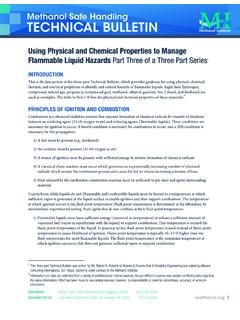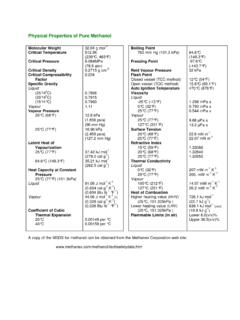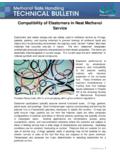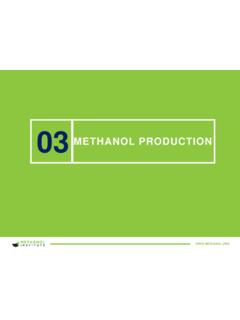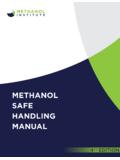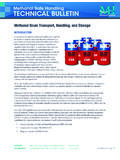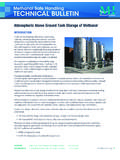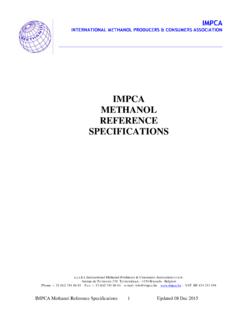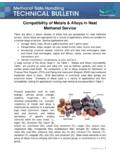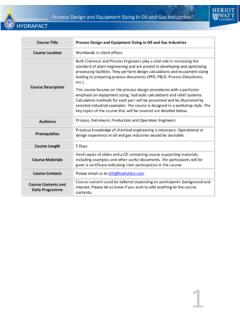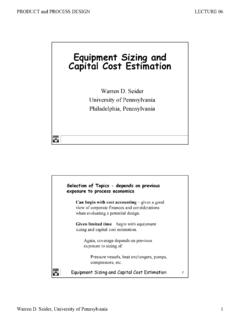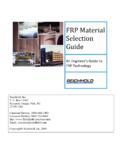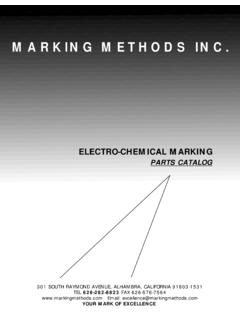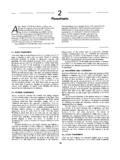Transcription of Materials Selection for Neat Methanol Service
1 1 Materials Selection for neat Methanol Service Preface This is the first of several technical bulletins addressing Materials Selection of metals, alloys, elastomers, rubber compounds, polycarbonates, and composites in Methanol Service . This first bulletin focuses on the overall Materials Selection process. The second and third bulletins address Selection of metals and alloys, and elastomers and rubber compounds in anhydrous ( neat or M-100) Methanol Service . The fourth bulletin addresses Selection of polycarbonates (plastics) and composite Materials for blended fuel Service , specifically M-10, M-15, and M-85.
2 Readers who have researched articles, references, and the many chemical compatibility charts that are available on the internet, know there is inconsistency from one source to another regarding which Materials are and are not suitable for Methanol Service . The diversity of answers is largely due to differences in assumptions regarding specifics of the intended application. This series of four Technical Bulletins addresses this issue by emphasizing Materials Selection relative to Materials application. Bulletin numbers 2 through 4 organize published information into a table format that enables evaluation of available choices with guidance on compatibility for specific applications.
3 Additional investigation beyond information presented in these four bulletins is needed to arrive at final choices and to write specifications necessary for facility design, and Materials procurement. The intent of these bulletins is to provide a structured starting point within a variety of possible choices. Methanol is manufactured, transported, stored, processed and utilized in a wide variety of purposes and applications including chemical feed stock, hydride control in oil and gas production, motor fuel additive, primary motor fuel (M-100), source of carbon for waste water de-nitrification, manufacture of bio-fuels, Methanol -based hydrogen fuel cells, and many others.
4 The array of operating parameters and circumstances is equally wide ranging. Each application has unique material requirements. Guidance in these bulletins is not a substitute for knowledgeable engineering evaluation of process-specific applications. Understanding your application in normal and abnormal operating conditions is essential. Abnormal operation includes all situations and circumstances other than those that are normally intended, and are within Materials Selection for neat Methanol Service (cont.) 2 designated design limits.
5 Pressure testing and startup are examples of abnormal conditions. Materials Selection must consider both normal and abnormal conditions. About Materials Selection Materials Selection is a complicated process that occurs as an iterative progression of considerations that emerge throughout the design process. The first step of Materials Selection uses a Process Flow Diagram (PFD) and associated process parameter operating envelopes and assigns material Safety Data Sheets (MSDSs) for process fluids that comprise unit operations within the PFD.
6 The second step characterizes basic design parameters for the types of equipment that comprise unit operations: , above-ground storage tanks (ASTs), reactors, vessels, columns, towers, furnaces, heat exchangers, piping and components, pumps, compressors, control elements, and their associated trim. The third step identifies design, fabrication, and construction codes and standards that must be followed in order to ensure that process fluids are confined within the equipment . This includes consideration of accepted engineering practices for mechanical integrity and sustained fitness-for- Service .
7 This also includes safety requirements for joint tightness and leak prevention. A standard is a document that applies collectively to codes, specifications, recommended practices, classifications, test methods, and guides, which have been prepared by a standards developing organization, and published in accordance with established procedures. Standards can be voluntary, consensus, or mandatory. Voluntary standards are developed by private sector bodies and are available for use by any person, company, or governmental organization.
8 Industry and consensus standards are voluntary unless they become mandatory as a result of use, reference, or adoption by a regulatory authority, or when invoked in commercial instruments such as contracts and purchase orders. Industry standards are developed by trade organizations for use within a particular industry through cooperation of all parties who have an interest in participating in development and use of the standards. Industry standards are voluntary consensus-type standards. Mandatory standards require compliance as a matter of governmental statute, regulation, organizational internal policy, or contractual requirement.
9 Failure to comply with mandatory standards implies sanction, such as criminal or civil penalties. Codes are standards, which have been codified by governmental authority, and are law within the jurisdiction of that authority. Standards are designated as regional, national, or international. Regional standards are those developed, adopted, or promulgated by regional organizations [ , European Committee for Standardization (CEN), and Pan American Standards Commission (COPANT)]. Regional standards are generally voluntary in nature. National standards are those adopted by a national standards body [ , American National Standards Institute (ANSI), Standards Council of Canada (SCC), Materials Selection for neat Methanol Service (cont.)]
10 3 British Standards Institution (BSI)] and made available to the public. As a practical matter, a national standard is any standard that is widely used and recognized within a country. Within this context, even governmental standards such as those issued by the Occupational Health and Safety Administration (OSHA) can be considered national standards. Although there is discussion and disagreement regarding what constitutes an international standard , there is some agreement that international standards must be used in multiple nations, and the development process must be open to all countries.
